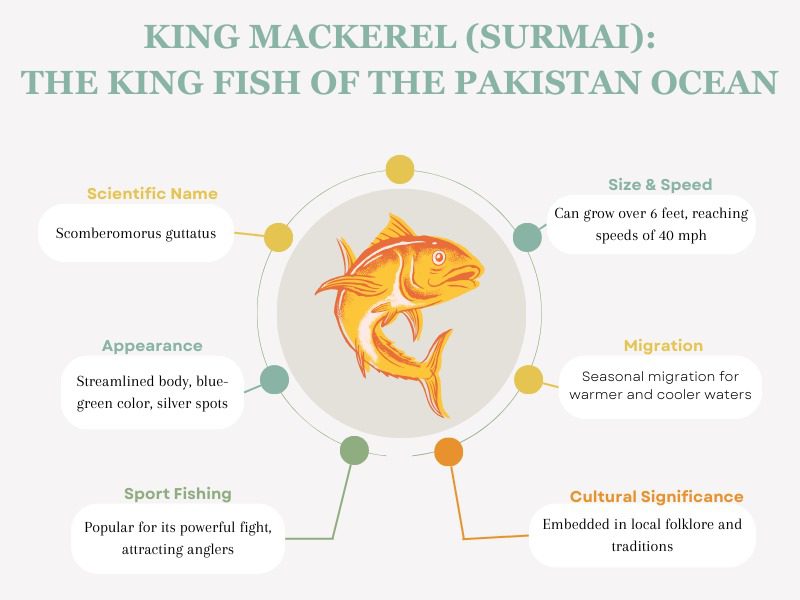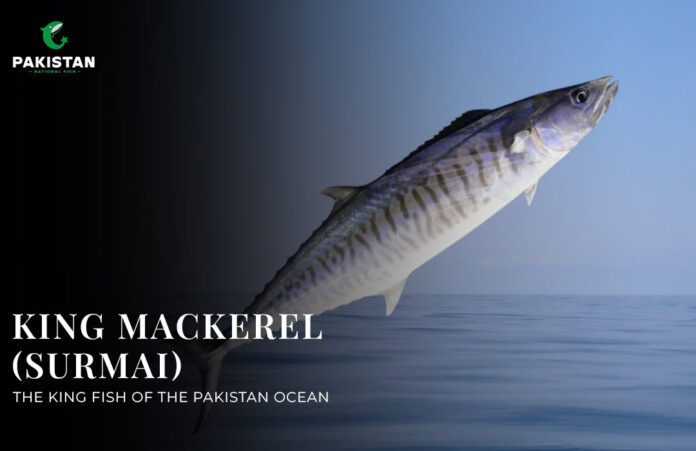The name of Surmai fish in English is king Mackerel, also known as Scomberomorus cavalla surmayi. It is a migratory mackerel species, found in the Gulf of Mexico and the western Atlantic Ocean. Commonly referred to as the surmai fish, this species is significant to both the commercial and recreational fishing sectors.
A fish of medium size, king mackerel can weigh anywhere from 5 kg (11 lb) to 14 kg (30 lb), though it has been known to weigh as much as 40 kg (90 lb). Very tiny, barely perceptible, loosely attached scales cover the entire body. The pelvic fins and the first (spiny) dorsal fin are typically folded back into a body groove. Both fins are entirely colorless. Starting high on the shoulder and dipping sharply at mid-body, the lateral line carries on as a wavy horizontal line to the tail. The back has an olive coloration that fades to silver, the sides have a rosy iridescence, and the belly is white.

Categorization
Domain
Eukaryota
Kingdom
Animalia
Phylum
Chordata
Class
Actinopterygii
Order
Salmoniformes
Family
Salmonidae
Subfamily
Salmoninae
Genus
Scomberomorus
Species
S. cavalla
Habitat and Prevalence of King Mackerel
Benefits Of King Fish (surmai)
- High Source of Vitamin B12: Essential for nervous system function and reducing anaemia risk.
- Important Source of Omega-3 Fatty Acids: Oily and rich in omega-3 fatty acids and essential fats. Consuming Surmai fish can increase omega-3 levels, reducing cardiovascular and all-cause mortality risk.
- Loaded with Protein: Complete source of amino acids that boost metabolism, muscle gain, and muscle wear and tear.
- Contains Relatively Low Levels of Mercury: Seafood, including Surmai, is relatively low in mercury, beneficial for health.
- Great for Joints: Treats joint swelling, atrophic arthritis, and osteoarthritis symptoms.
- Boosts Eyesight: Vitamin A and retinol in Surmai help maintain strong eyesight and curb age-related macular degeneration.
- Increases Brain Power: Omega-3 fatty acids lower depression chances and prevent post-natal depression and dementia symptoms.
- Great for the Skin: Provides moisture, reduces psoriasis and eczema, and boosts collagen production, and increases skin firmness and elasticity.
Indo-pacific King Mackerel -king Fish Name In Multiple Languages
Regions And Languages
Other Names Of King Mackerel
Patterns of Migration of king Mackerel
DID YOU KNOW?
According to the United States Food and Drug Administration, king mackerel is one of four fishes, along with swordfish, shark, and tilefish that children and pregnant women should avoid due to high levels of methyl mercury found in these fish and the consequent risk of mercury poisoning.
Past life Circumstances of King Mackerel
Feeding Behaviours of Surmai Fish
Appropriate and carnivorous, surmai, also known as king mackerel, are voracious eaters. Their size determines what they prey on. They prefer the following species, depending on the region and time of year: grunts (Haemulidae), striped anchovies (Engraulidae), cigar minnows, threadfin, northern mackerel, jacks (Carangidae), cutlassfish (Trichiuridae), squid, menhaden, and other sardine-like fish (Clupeidae). They do not attack people; instead, they will bite to protect themselves from perceived threats, such as people flailing or thrashing in man-overboard and similar situations.
Fisheries
- In the sport fishing world, king mackerel are renowned for their lightning-fast runs, matching the speed of their distant relative, the wahoo.
- The primary method of catching them is trolling, which involves spoons, jigs, live and dead baitfish, and other artificial lures.
- Run-around gill nets make up commercial gear. Commercial anglers also use large planers, heavy tackle, and lures akin to those sport anglers use to catch them while trolling.
- Usually, a strong metal leader is tied to two hooks when using live bait. The first is hooked through the mouth or nose of the live bait and can be a single or treble.
- The second hook, also known as the treble hook, is either left free to swing or inserted through the top of the fish’s back. King mackerel frequently bite the tail portion of a bait fish, so this has to be done.
- Ensuring the baitfish swims correctly is critical when using this technique to troll for kings. Typical tackle consists of a 2 m (6 ft 7 in), 13 kg (29 lb) class rod and a conventional or spinning reel that can hold 340 m (370 yd) of 13 kg (29 lb) test monofilament.
- Due to this species’ popularity as a sport fish, numerous organizations have successfully promoted tournament events. The most well-known are the Southern Kingfish Association (SKA) and the FLW Outdoors tour. Multiple print and online outdoor publications have coverage of these events.
Surmai Fish as Food
Types of Surmai fish
1. Jack mackerel
2. Spanish Mackerel
3. King Mackerel
King mackerel (Scomberomorus cavalla) are kings, kingfish, cavalla, carite, or sierra. They are in the family Scombridae, which also includes tunas and bonitos. The king mackerel has a streamlined body, with a tapered head and tiny scales that cover the entire body except the pectoral fins.


